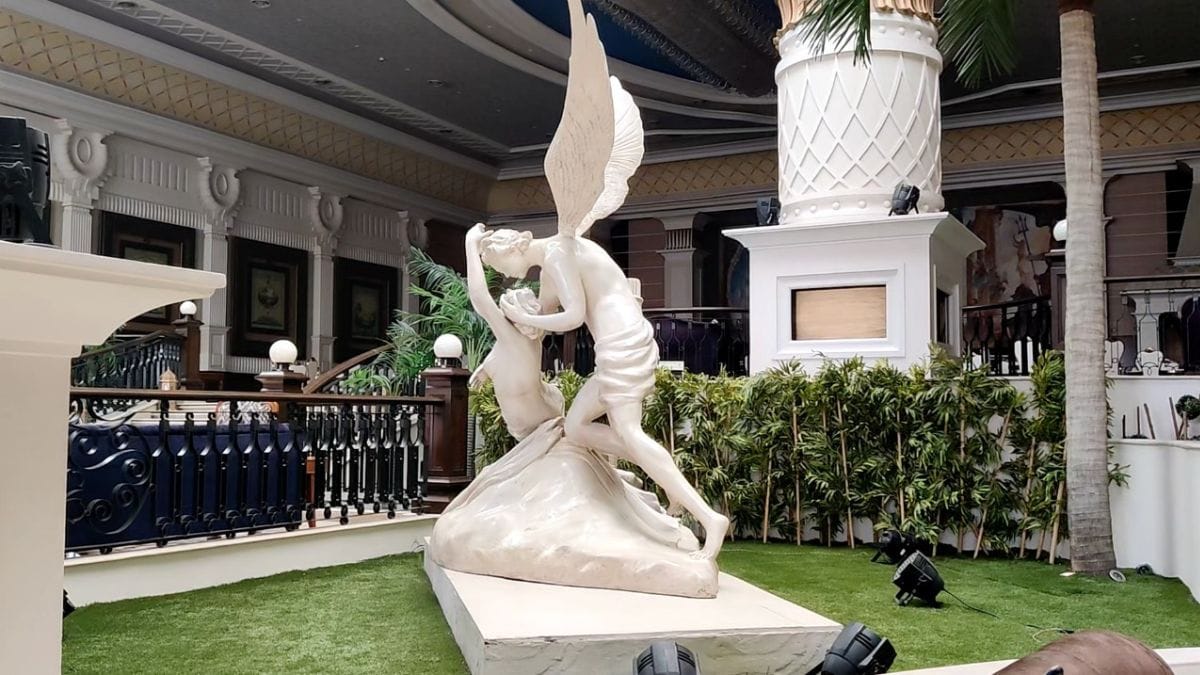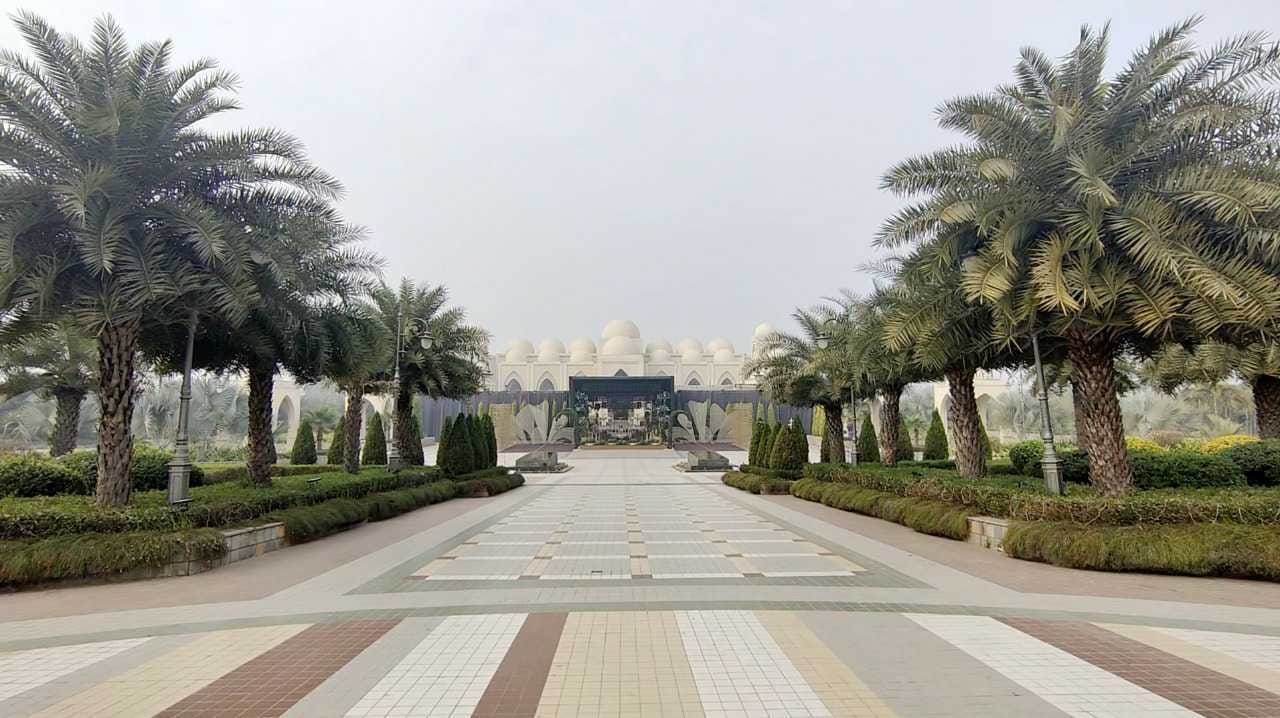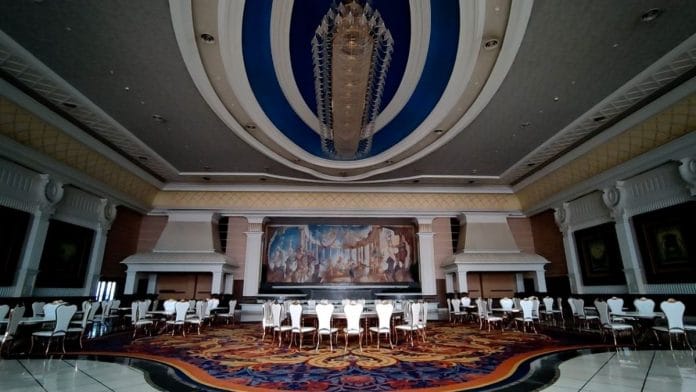Mohali: Why pay tens of lakh extra for a royal wedding in Udaipur or Jaipur when there’s a choice between the gilded glory of Dubai and Greek-style grandeur right at Dera Bassi road in Punjab’s Mohali?
For Punjab’s ‘aristocracy’, the two wedding palaces here — The Grand Orient and The Palace — tick all the boxes. They scream extravagance but are relatively budget-friendly compared to most destination wedding locations. Despite looking ‘foreign’, they are just a short drive from Chandigarh.
Even Punjabi pop stars gravitate to them. Badshah’s hit Top Tucker and Sidhu Moosewala’s Burberry both feature The Palace. Look out for the drone shots of gleaming white domes and opulent interiors in the former, and the huge arched doorway, high ceiling mirrors, and colourful glasswork in the latter.
The availability of open land to hold gatherings may be shrinking, but the demand for Big Fat Punjabi Weddings is only growing. As a result, wedding palaces are highly sought after for their lavish banquet halls and expansive grounds that lend the feel of a landed estate.
The biggest ones, according to sources in the local wedding ecosystem, are built on properties once held by NRIs who are cashing out after selling their land in Punjab. “When there’s nothing left in the farms, selling is the only option,” explained Sukhbir Singh Sidhu, the president of Punjab’s Marriage Palaces Association.
But beneath the gloss, there is a seamy side to the burgeoning wedding palace industry.
There are 5,500 of these venues peppered around Punjab, according to the Marriage Palace Owners Association. Of these, only 1,200-1,500 have been regularised, which means that the rest are operating illegally without necessary permits and may not follow safety standards.
It’s telling, perhaps, that Chief Minister Bhagwant Mann last month ordered the state police to set up checkpoints equipped with breathalysers outside wedding halls to help curb the problem of drunk driving.
“Most palaces don’t file taxes, don’t take permits, they serve alcohol without liquor permits. They play music till late at night. They don’t have fire safety guidelines in place either,” a member of the Punjab Marriage Palace and Resorts Owners Association told ThePrint.
Also read: Has Instagram changed the way Indians consume big fat celebrity weddings?
Rich weddings, poor compliance
The thousands of wedding palaces in Punjab can make fairy-tale fantasies come true for brides and grooms across the social divide, according to Sidhu.
“No matter what your income is, everyone wants a dreamy wedding, and there’s nothing wrong with that. Marriage palaces, big or small, help people have their dream wedding,” he said.
When it comes to more down-to-earth matters like permits and paperwork, however, most venues fall short.
The situation is no better than what it was five years ago, when the Punjab Urban Development Authority (PUDA) notified its new policy for the regularisation of wedding palaces.
The August 2017 notification conceded that marriage palaces were a “social necessity” due to the “scarcity of common spaces” but that they needed to adhere to building norms and meet standards for “public safety,” adequate parking, and so on.
Back then, the authority stated that it had received 1,093 applications for regularisation but approved only 109 of them, and issued CLU (change of Land Use) for 401. The rest, it said, did not meet the required criteria.
Since then, little has changed. Most wedding palaces are still unregularised even though the 2017 PUDA notification warns of a hefty fine, disconnection of water and electricity, sealing of premises, and even demolition for marriage palaces that don’t have permits.
According to Sidhu, the reason for the lack of compliance is that building by-laws were notified only in 2016, by that time most such establishments in the state were up and running.
High costs and impractical requirements were also deterrents to seeking regularisation, he added.
“When a building has already been erected, you cannot change the plan according to the land use that was introduced by the government in 2016. The charges for change of land use were also hefty, in the range of Rs 1-2 crore, so people didn’t bother getting regularisation,” he said.
ThePrint couldn’t confirm if The Palace and Grand Orient are regularised or not.
Also read: After K-pop, K-drama, K-food, Indian fans are now getting married the Korean way
‘People from Jaipur & Udaipur come here…’
Who says the heritage palace-cum-hotels of Rajasthan have a monopoly on the royal wedding dream? Destination Chandigarh offers the feel of royalty for half the price.
“A destination wedding in Udaipur will cost you at least Rs 70 lakh to 1 crore for hosting 200-300 people. At The Palace and Grand Orient, you can get the same experience for Rs 35 lakh. So, people are choosing these wedding halls. 40 per cent of the weddings I’ve organised are booked here,” said Gagandeep Singh, proprietor of Jai Hind Weddings in Chandigarh.
The clientele, by all accounts, includes the crème de la crème of Punjabi society, from ministers and top officials to singers and actors.
Local people claimed that the guest lists of some weddings have included CM Bhagwant Mann, rapper Honey Singh, and singer Gurdas Maan.
“Almost anyone important in Punjab has held their wedding reception here. Bureaucrats, ministers and whatnot. But I can’t tell you the names,” said Rajinder Sharma, manager of The Grand Orient.
“People from Jaipur and Udaipur come here for their destination weddings,” he added, smirking with pride.
Both The Grand Orient and The Palace are set on sprawling grounds and feature soaring ceilings and sumptuous settings, but their aesthetics are quite distinct.

Sitting on 10 acres, The Grand Orient draws its inspiration from Greek architecture even if the results are more Vegas than Athens. Think vast columns, ornate paintings, and a grand marble staircase leading up to a dining area for the bride, groom, and intimate family, set up with heavy, intricate cutlery.

The Palace, on the other hand, has a more Middle Eastern feel to it. Located on a 12-acre property, the building features at least 20 domes of various sizes, while the interiors are resplendent with chandeliers and throne-like chairs.

“It took us three years to build this property,” its owner Angad Makkad said, adding that he is planning to expand the structure and make cottages for guests to stay in.
According to Jai Hind Wedding Planners, the cost of booking The Palace for a night is at least Rs 15 lakh. Catering, decoration, and music are not included.
Both the venues currently have no provision for the guests to stay and are predominantly used just for wedding receptions and for the shoots of Punjabi and Haryanvi films and songs. Badshah, Sidhu Moosewala, Sapna Chaudhary, Ammy Virk, and Mankirat Aulakh are just some of the stars who have shot their songs here.
What sets these spaces apart is that they provide space for unfettered extravagance.
“People want to arrive in helicopters to these weddings,” owner of Jai Hind weddings said. “A Jaipur palace may not be able to fulfil that wish. The Palace and The Grand Orient can.”
(Edited by Asavari Singh)






